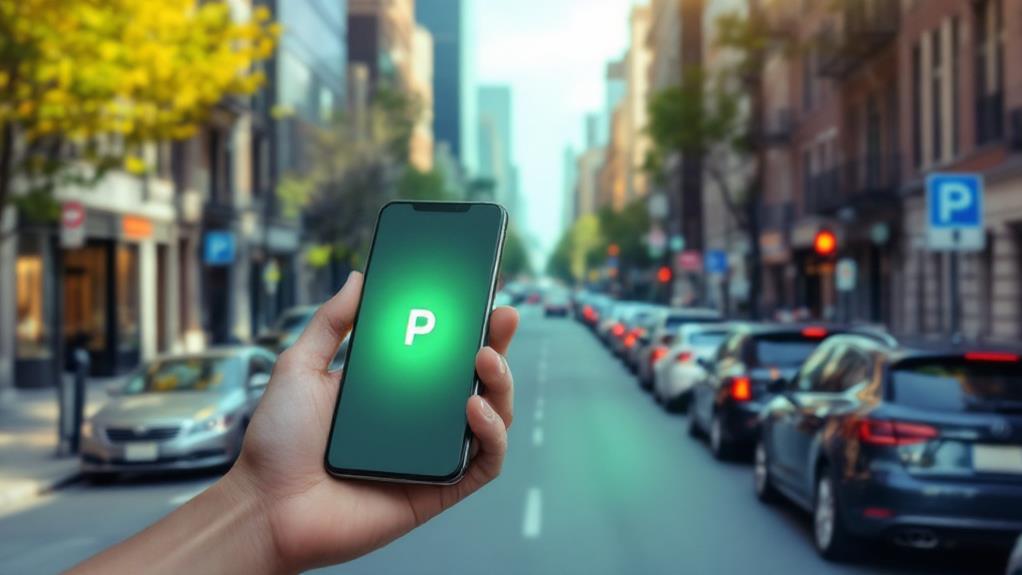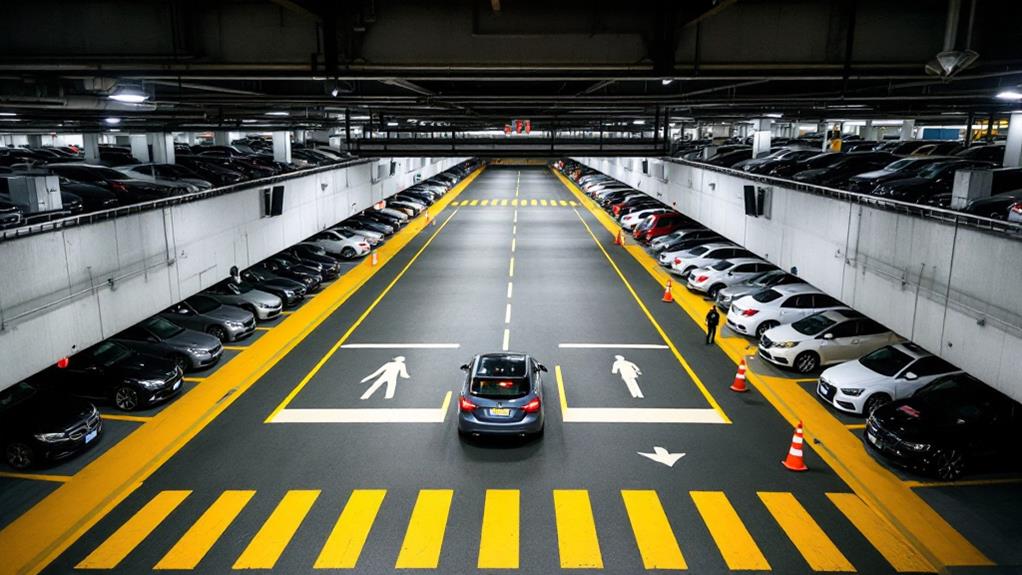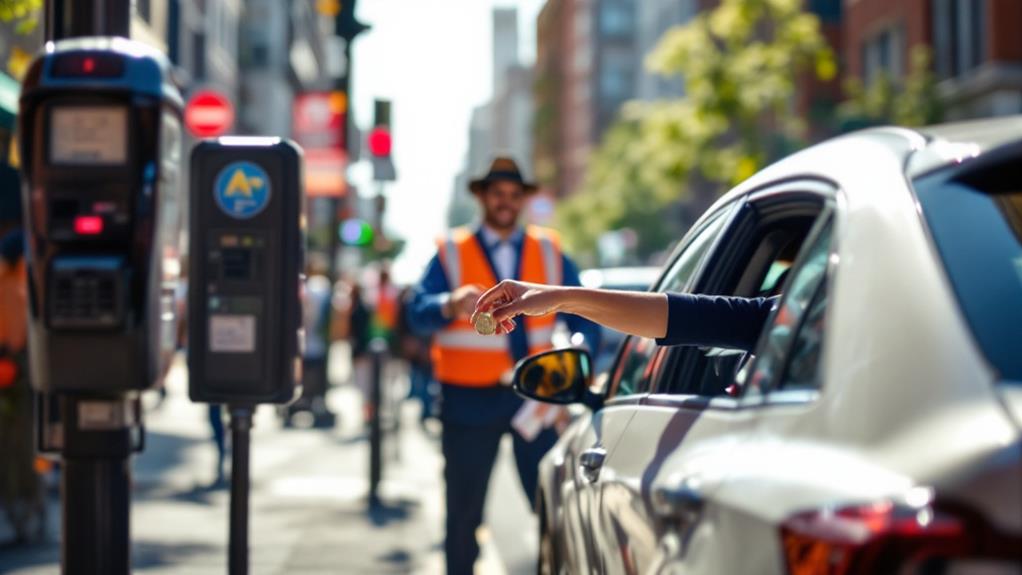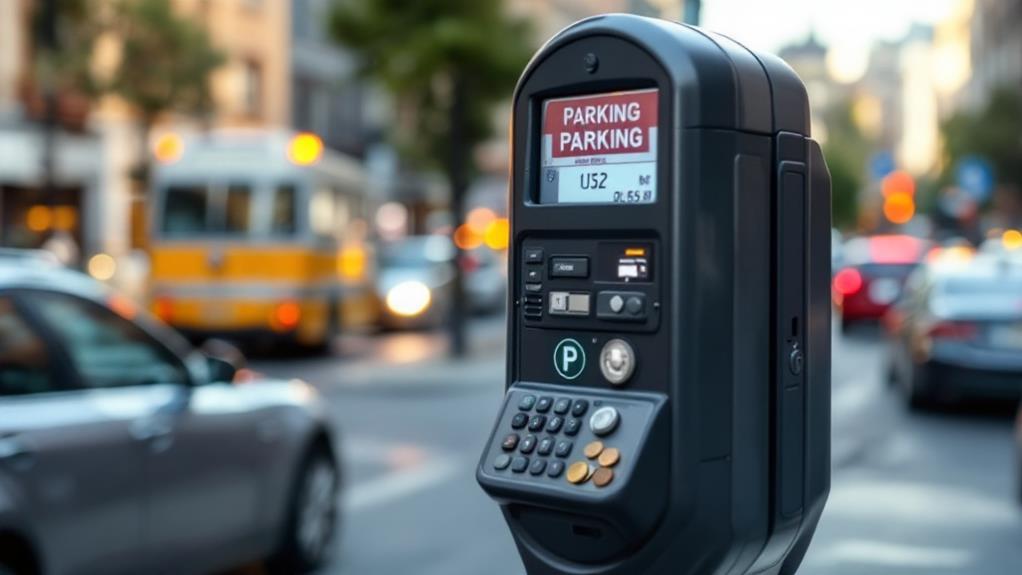How to Avoid Car Damage When Parking in Crowded City Spaces
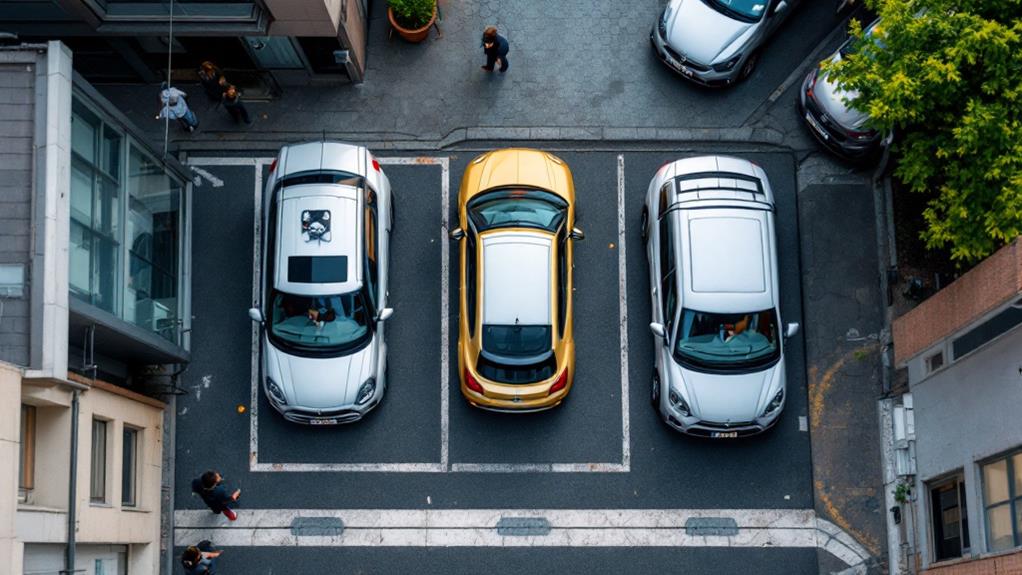
To avoid car damage in crowded city parking, start by carefully evaluating available spaces. Choose strategic spots like corner spaces or end-of-row locations for better clearance. Use your vehicle's technology, including cameras and sensors, to navigate tight spots confidently. Achieve precision parking techniques through practice, and protect your car's exterior with regular waxing and protective accessories. Move slowly and steadily, staying aware of your surroundings at all times. Enlist passenger help when possible, and know your vehicle's exact dimensions. By planning your exit strategy beforehand, you'll set yourself up for a smooth departure. These tips are just the beginning of becoming a parking expert.
Assess Available Space
When it comes to parking in crowded city spaces, evaluating the available space is essential for avoiding car damage. Before attempting to maneuver into a spot, visually inspect the parking spaces to guarantee they can accommodate your vehicle's size and turning radius. This is especially crucial when parallel parking or navigating through crowded parking lots.
Measure the space between adjacent vehicles to confirm you have enough room to park safely. Don't assume there's enough space based on a quick glance; take a moment to assess the situation carefully. Consider the proximity of other obstacles like walls, poles, or shopping carts that could impact your maneuvering. These factors can greatly affect how much space you actually have to work with.
Evaluate the parking lot layout, including aisle width and traffic flow, to anticipate potential challenges. This will help you determine if you have enough room to execute your parking maneuver safely. Prioritize spots that provide ample clearance on all sides to minimize the risk of bumping into other cars. Remember, it's better to spend a few extra minutes finding a suitable spot than to rush and potentially damage your vehicle.
Choose Strategic Parking Spots
Savvy drivers know that picking the right parking spot can make all the difference in protecting your vehicle. When parking lots are filled, you'll need to take extra care in choosing where to leave your car. Opt for the first or last spot on a block to minimize the risk of being boxed in by other vehicles. Corner spots are also ideal, as they provide more clearance and make it less likely for your car to get scratched or dented.
Always seek out well-lit areas, especially if you'll be parking for an extended period. This simple strategy can deter potential vandals and thieves. When parallel parking, don't try to squeeze into a tight space. Instead, look for a more spacious spot that allows you to maneuver easily without risking damage to your car or others.
Avoid parking under trees, even if they seem to offer shade. Bird droppings and tree sap can wreak havoc on your car's paint job. By choosing strategic parking spots and being mindful of your surroundings, you'll greatly reduce the chances of returning to a damaged vehicle in crowded city spaces.
Use Technology Wisely
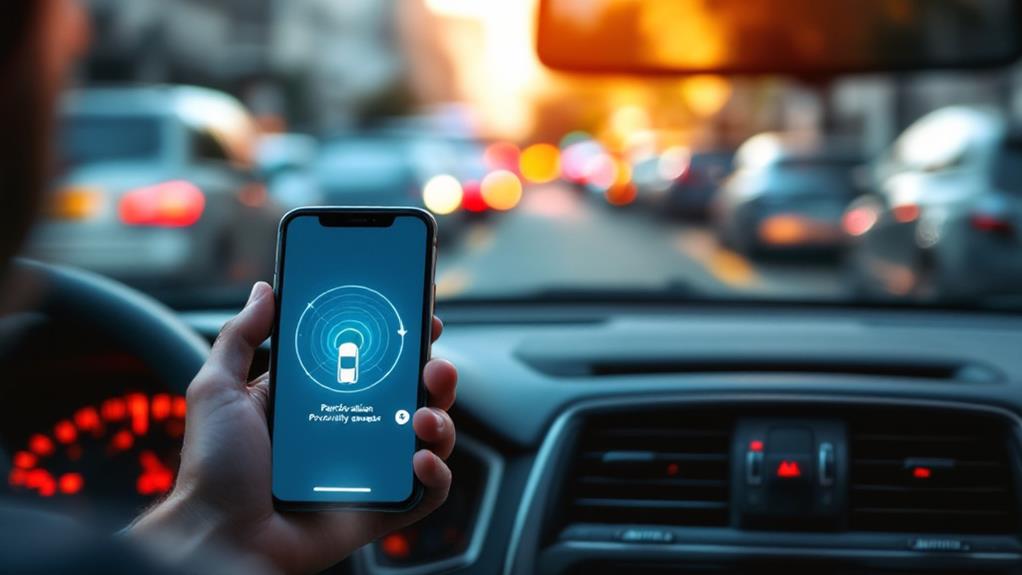
In the age of smart vehicles, technology can be your best ally when maneuvering tight parking spaces. Don't overlook the essential features your car may offer to help protect it from damage and theft in crowded urban environments.
Make the most of backup cameras and parking sensors to navigate through tight spots with confidence. These tools provide critical information about your surroundings, helping you avoid obstacles and other vehicles. If your car is equipped with a 360-degree camera view or automated parking assistance, use these features to enhance your spatial awareness and parking precision.
When parking at night, take advantage of adaptive headlights that swivel with your steering wheel, improving visibility as you maneuver into and out of spaces. Blind spot monitoring systems can alert you to vehicles you might not see, reducing the risk of side collisions during parking.
Pay attention to digital displays that show your distance from objects, using this feedback to guide your movements. While these technologies are helpful, don't forget basic security measures like steering wheel locks to deter car thieves. By combining advanced features with common-sense precautions, you'll minimize the risk of damage and theft in crowded city parking areas.
Master Precision Parking Techniques
While technology can be a helpful tool, perfecting precision parking methods is equally important for maneuvering crowded city areas. To command these techniques, start by practicing parallel parking in less crowded areas. As you improve, challenge yourself with tighter spaces. When parking, always approach slowly and at the correct angle. Use your side mirrors to gauge the distance between your car and other vehicles.
For perpendicular parking, learn to judge your car's turning radius. This will help you make smooth, controlled turns into tight spots. When backing into a space, use reference points on your car to align yourself properly. You can make small adjustments by inching forward or backward as needed.
Remember to fold in your mirrors when parking in extremely tight spaces. This simple step can prevent damage and give you extra room to maneuver. Always leave enough space on both sides to open your doors without hitting adjacent cars. If you're unsure about a spot, it's better to find another rather than risk damaging your car or others. With practice, you'll develop the confidence and skill to park precisely in even the most challenging urban environments.
Protect Your Vehicle's Exterior
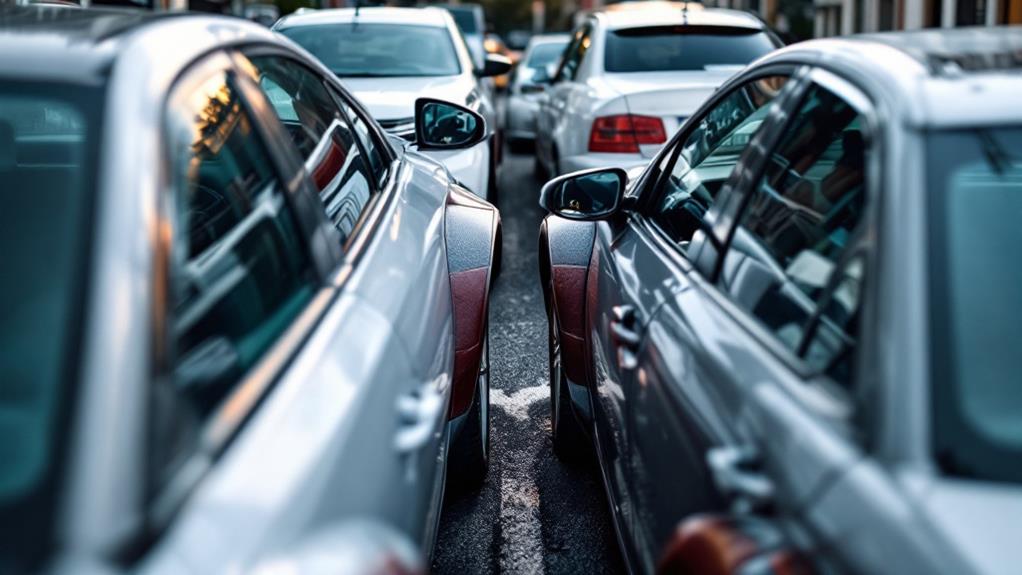
Protecting your vehicle's exterior is essential when parking in crowded city spaces. When you're in a parking garage or on a busy street where cars are parked much closer together, it's a good idea to take extra precautions. Start by applying a protective wax coating regularly to maintain your car's paint and finish. This will help prevent damage from environmental factors like bird droppings and tree sap, which can be much more prevalent in urban areas.
Consider using a car cover, especially if you're parking for extended periods. Choose from semi-custom to custom covers in various materials suitable for indoor or outdoor use. Don't forget to fold in your side mirrors when parked to avoid breakage. Installing bumper guards or protective strips is another smart move to absorb minor impacts in tight spaces.
Maintain your vehicle's exterior by washing it every two weeks and spot-treating bird droppings, bug guts, and tree sap with specialized products. Employ features like parking sensors, rearview cameras, and parking assist to prevent bumper damage when maneuvering in cramped city parking spots.
Be Aware of Surroundings
Remain vigilant when traversing crowded city parking spaces to avoid potential damage to your vehicle. Constantly scan for pedestrians, moving vehicles, shopping carts, and other hazards. Be especially cautious of cars parked nearby and the car in front of you when maneuvering.
Utilize your vehicle's technology to enhance awareness. Rearview cameras, blind spot monitoring, and parking sensors can help you detect obstacles you might miss visually. However, don't rely solely on these tools. Maintain a 360-degree awareness by checking mirrors and looking over your shoulder.
Adjust your driving speed to 5 mph or less in parking areas. This slower pace allows more time to react to unexpected obstacles, reducing the risk of collisions. As you negotiate tight spaces, rely on both visual and audio cues to stay alert.
When you leave your car, avoid distractions like mobile devices. Stay focused on your surroundings to prevent accidents or damage. Remember, parking lots and garages can be unpredictable environments, so remain attentive from the moment you enter until you safely exit the area.
Slow and Steady Wins

Taking a slow and steady approach is key when parking in crowded city spaces. As you maneuver your vehicle into a tight spot, remember that rushing can lead to costly mistakes. The old adage "slow and steady wins" applies perfectly to urban parking scenarios.
When you're inching your way between two cars, take your time and be patient. Hasty movements increase the risk of minor scratches or more severe damage. Use your mirrors and parking sensors if available, and don't hesitate to stop and reassess your position if needed. It's better to take an extra minute than to rush and regret it later.
Consider these safety tips: First, turn off the radio and open your windows to better hear your surroundings. Second, if possible, ask a passenger to guide you from outside the vehicle. Third, use your hazard lights to alert other drivers of your intentions. Ultimately, if the space feels too tight, don't force it – look for another spot. By adopting a calm and careful approach, you'll greatly reduce the chances of damaging your car or others' vehicles in crowded parking situations.
Leverage Passenger Assistance
A precious resource for maneuvering tight parking spots is right beside you - your passenger. Don't overlook this invaluable asset when tackling challenging city parking situations. Your passenger can act as an extra set of eyes, providing essential feedback to help you avoid bumper damage and navigate confined spaces safely.
Next time you're parking in a crowded lot or attempting a tricky parallel park, enlist your passenger's help. They can spot obstacles, judge distances, and communicate with you to ensure a smooth parking job. This extra layer of protection is especially vital in bustling urban areas where tight spaces and numerous hazards make it difficult to gauge clearance.
Here's how to leverage passenger assistance effectively: Ask them to step out of the car if needed, keeping the key fob with them. Explain what they need to look for, such as nearby vehicles, poles, or curbs. Establish clear communication signals beforehand. While you focus on controlling the vehicle, your passenger can monitor the surroundings and provide verbal cues. This teamwork approach allows you to park confidently and safely, minimizing the risk of costly bumper damage in challenging urban parking scenarios.
Know Your Vehicle's Dimensions
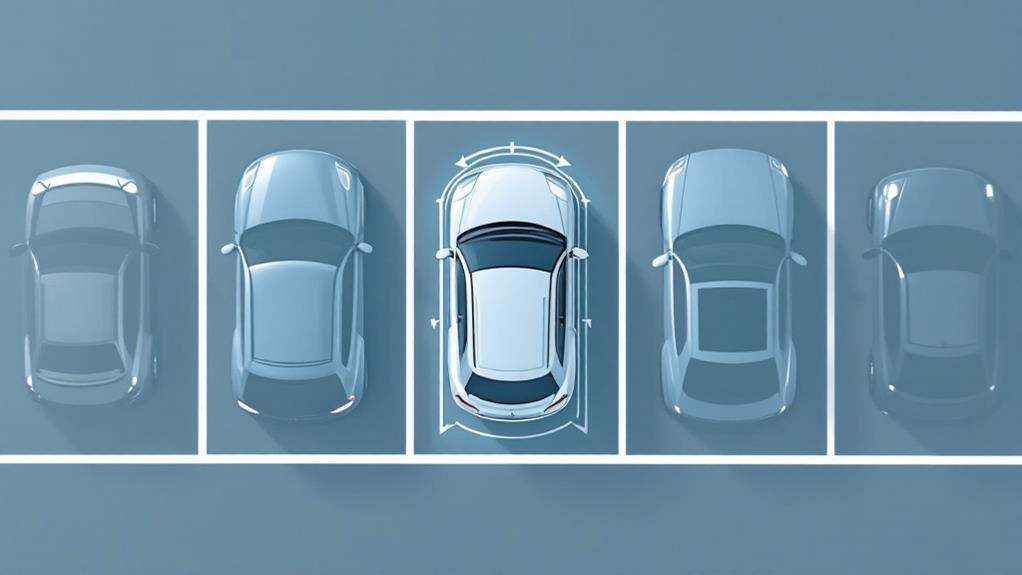
Understanding your vehicle's exact dimensions is a essential step in commanding urban parking. You'll need to know your car's length, width, and turning radius to manage tight spaces confidently. Consult your owner's manual or measure your vehicle to get precise figures. This knowledge is indispensable for preserving your paint job and avoiding scrapes in cramped city lots.
If you're driving an SUV or truck, remember that these vehicles require more space to maneuver than compact cars. Their larger size means you'll need to be extra cautious when squeezing into small spots. On the other hand, if you're behind the wheel of a compact car, you'll benefit from its tighter turning circle, making it easier to park in constrained areas.
Plan Exit Strategy Beforehand
Many seasoned city drivers swear by planning their exit strategy before parking. This approach can save you time, frustration, and potential damage to your car. Every time you park, there are steps you can take to guarantee a smooth departure.
Before settling into a spot, scout the area and visualize how you'll leave. Consider the best exit route that won't require complex maneuvering. If possible, position your car to allow for a forward exit rather than backing out. You'll need to look for any obstacles or tight spaces that might hinder your departure and plan accordingly.
Familiarize yourself with your vehicle's dimensions and turning radius. This knowledge will help you anticipate clearance needs and make your car easier to maneuver in tight spaces. When parking, leave enough room on all sides to open doors without hitting adjacent vehicles or objects.
